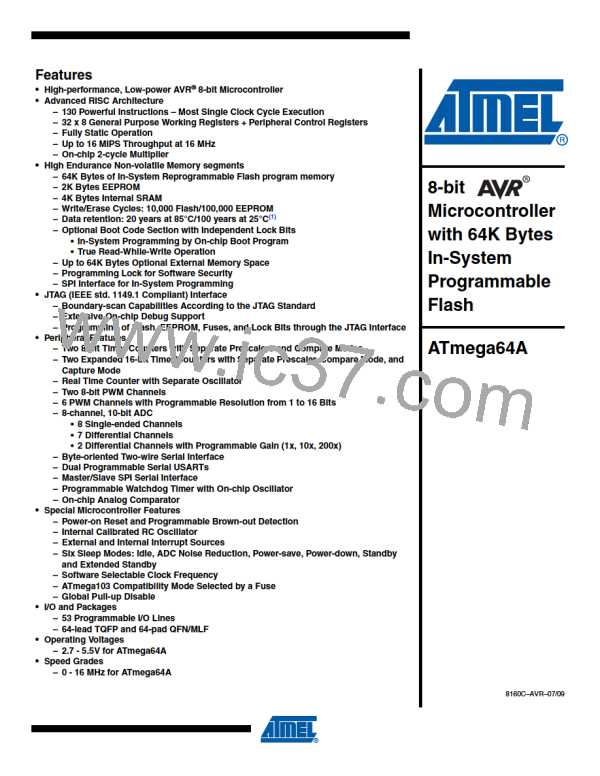ATmega64A
The Timer/Counter Overflow Flag (TOV2) is set each time the counter reaches BOTTOM. The
interrupt flag can be used to generate an interrupt each time the counter reaches the BOTTOM
value.
In phase correct PWM mode, the compare unit allows generation of PWM waveforms on the
OC2 pin. Setting the COM21:0 bits to two will produce a non-inverted PWM. An inverted PWM
output can be generated by setting the COM21:0 to three (see Table 17-5 on page 159). The
actual OC2 value will only be visible on the port pin if the data direction for the port pin is set as
output. The PWM waveform is generated by clearing (or setting) the OC2 Register at the Com-
pare Match between OCR2 and TCNT2 when the counter increments, and setting (or clearing)
the OC2 Register at Compare Match between OCR2 and TCNT2 when the counter decrements.
The PWM frequency for the output when using phase correct PWM can be calculated by the fol-
lowing equation:
f
clk_I/O
f
= -----------------
OCnPCPWM
N ⋅ 510
The N variable represents the prescale factor (1, 8, 64, 256, or 1024).
The extreme values for the OCR2 Register represent special cases when generating a PWM
waveform output in the phase correct PWM mode. If the OCR2 is set equal to BOTTOM, the out-
put will be continuously low and if set equal to MAX the output will be continuously high for non-
inverted PWM mode. For inverted PWM the output will have the opposite logic values.
At the very start of period 2 in Figure 17-7 OCn has a transition from high to low even though
there is no Compare Match. The point of this transition is to guarantee symmetry around BOT-
TOM. There are two cases that give a transition without a Compare Match.
• OCR2 changes its value from MAX, like in Figure 17-7. When the OCR2 value is MAX the
OCn pin value is the same as the result of a down-counting Compare Match. To ensure
symmetry around BOTTOM the OCn value at MAX must correspond to the result of an up-
counting Compare Match.
• The timer starts counting from a higher value than the one in OCR2, and for that reason
misses the Compare Match and hence the OCn change that would have happened on the
way up.
17.8 Timer/Counter Timing Diagrams
The Timer/Counter is a synchronous design and the timer clock (clkT2) is therefore shown as a
clock enable signal in the following figures. The figures include information on when interrupt
flags are set. Figure 17-8 contains timing data for basic Timer/Counter operation. The figure
shows the count sequence close to the MAX value in all modes other than phase correct PWM
mode.
155
8160C–AVR–07/09

 ATMEL [ ATMEL ]
ATMEL [ ATMEL ]